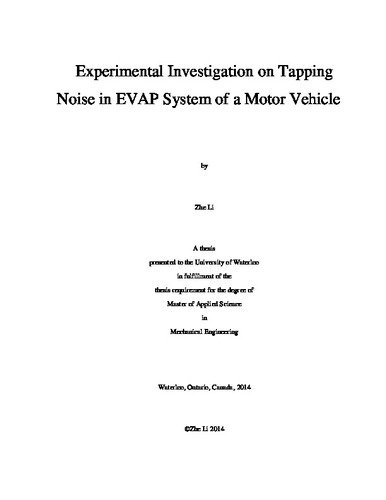| dc.description.abstract | Within automotive industry, Noise, Vibration and Harshness (NVH) has emerged to be one of the main research topics. Unlike attributes such as vehicle safety, drivability, and durability which are functionality criteria, NVH is closely tied to quality and comfort of the ride. The recent trend in consumer market shows that NVH is becoming increasingly important in purchasing decisions and can significantly affect competitive edge of vehicles.
Among various factors that contribute to vehicle noise, pressure pulsation inside vehicle fuel system has been subject to studies for several decades. In gasoline vehicles, with the introduction and wide spread of returnless fuel delivery system, the pressure pulsation phenomenon has become more and more prominent and has raised several issues, including noise. Similar phenomenon can be found in EVAP system where pressure is small. However, the information regarding pressure pulsation and noise issue in EVAP system is very limited.
This thesis investigated the noise issue caused by pressure pulsation inside EVAP system of a current production vehicle by one of the major automotive Original Equipment Manufacturers (OEM). There are two main parts in this research. First part is to build a test stand integrating the original parts provided by the OEM to re-create the noise, then to observe and collect data on the noise issue to understand the noise generation mechanism. Second part of this research is to, through literature survey, generate ideas on noise reduction, and then to test these ideas. Due to limited information, literature survey was focused on researches done on the fuel delivery system.
By collecting and analyzing pressure data on various running conditions, utilizing inspection camera, and carefully designed experiments, this research made findings on pressure pulsation and noise phenomenon, examined possible scenarios for the noise generation mechanism, and provided key evidences regarding various components and their effects on the pressure pulsation/noise. This thesis presented 8 different approaches to achieve noise reduction. Among those, 5 focused on pressure pulsation attenuation, which heavily drew inspiration from pulsation attenuation methods used in fuel delivery system. The methods tested in this thesis achieved various degree of success in noise reduction. However, each had its own drawbacks: they caused flow restriction in the line, and/or reduced the vacuum level going to the fuel tank system, and/or required design changes on critical parts in the system. | en |

